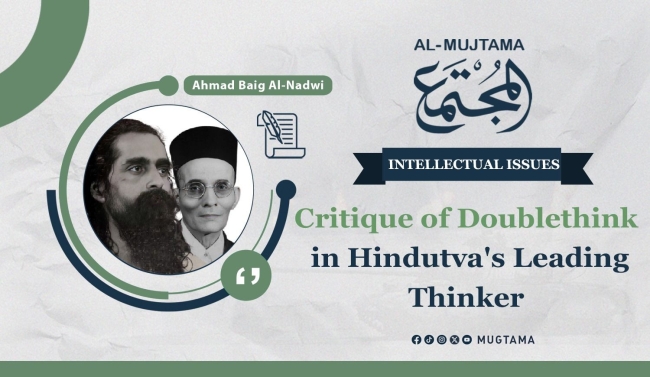The personality of Vinayak Damodar Savarkar (1883 – 1966) has become prominent and a key figure in current Indian politics, especially since the 1990s, when the leader of the Bharatiya Janata Party, L.K. Advani, began to present him as a genius model and an ideal hero in contemporary Indian history to exploit political gains, to the extent that his portrait was hung alongside that of Mahatma Gandhi in the Indian Parliament on February 26, 2003.
A Brief Overview of His Life
Vinayak Damodar was born into a well-known Brahmin family in the Savarkar caste (the highest rank among the upper Hindu classes) in the village of Bhagur near the city of Nashik in Maharashtra. From a young age, he was passionate about reading books and was highly intelligent, memorizing everything he read by the time he was not yet ten years old, and he began composing poetry in Marathi.
His mother died of the plague when he was nine years old, and in 1899, his father also passed away. He enrolled at Fergusson College in Pune, Maharashtra in 1902, where he forged relationships with many political Hindu leaders.
He went to London to study law, and during his studies there, he helped direct a group of Indian revolutionaries towards methods of sabotage and assassination, culminating in the assassination of a British officer in London by Madan Lal Dhingra, who was an active member of the movement Savarkar co-founded in London. Savarkar was charged with complicity in the officer's assassination and was arrested on March 13, 1910 in London. He was imprisoned, spending more than 13 years behind bars, most of which were on the Andaman Islands, until he was released on January 6, 1924.
Two Contradictory Pages of His Life
The first page, covering the period prior to his imprisonment, is filled with positive actions aimed at liberating the country from British colonial rule. During this time, he emerged as an excellent ambassador representing the sentiments and aspirations of all Indian citizens in general, and he authored a book titled "History of the National Liberation Movement," highlighting the remarkable features of unity between Hindus and Muslims in preserving the national entity.
The second page, which begins with his arrest in 1910 and continues to the end of his life in 1966, is a dark chapter filled with extremism, sectarianism, injustice, and hatred towards Muslims and their glorious history in India. It showcases how Savarkar transformed from being a builder to a destroyer, from representing unity to advocating for separatism, shouting that there are two different nations in India. He presented the two-nation theory before Muhammad Ali Jinnah, the founder of Pakistan, which ultimately led to India's partition in 1947.
In fact, behind the change in Savarkar's attitudes were two powerful motivators: one was his relationships with many political Hindu leaders who carried the totality of Hindu nationalist ideology, such as Sharada Nand (1856 – 1926), Lala Lajpat Rai (1865 – 1928), Bal Gangadhar Tilak (1856 - 1920), among others; Savarkar was influenced by the ideas of these extremists, which turned him upside down.
"And the other who focuses on achieving personal interests to secure life is bowing to the British Government of India; he asked for their pardon and for his release from prison, not once, but five times, as Dr. D. R. Goyal revealed this fact, stating: Savarkar wrote to the British government requesting pardon five times, in which he promised that he would rectify his actions and live his life according to what the merciful and just English rulers desire; he regarded himself as a disobedient son who feels a deep longing and a burning desire to return to the embrace of his mother; that is, the English rulers, to whom he had wronged in ignorance and negligence.
Hindutva in Savarkar's Perspective
The theory of "Hindutva" is one of the most dangerous extremist theories, not only against Muslims but also against the general human values that Savarkar presented in his book "Hindutva: Who is a Hindu," which he wrote while imprisoned in Ratnagiri prison in the state of Maharashtra in 1923, later sending it out for printing. According to Shams al-Islam, Savarkar could not have sent it out of prison without collusion with the English officers, and the first edition was printed under the name "Marathi" because Savarkar was in prison, and the laws of the country at that time did not allow him to print under his name.
The book "Hindutva" is not large in size, but it is a deadly poison and a destructive explosive for Indian society, which is based on religious, cultural, and linguistic diversity. Savarkar states that "Hindutva" is not just an abstract word, but an independent history. He added that its meanings encompass all aspects of the complete existence of the Hindu element and the ideas, movements, and practices associated with it.
He states that a Hindu is defined as one who considers the land stretching from the River Sindhu to the sea as their land of ancestors and motherland as well, and they are all connected by the bonds of race, culture, and language. As for Christians and Muslims, most of whom were Hindus not long ago, having converted to Islam a generation or two ago, they are not Hindus, even if they share with us the land of ancestors; for they have become different from us in our culture. Similarly, India is not the center of their charitable work, as their center is in the Arabs and Palestine, far away from our land. Naturally, India has long been a Hindu nation, consisting of a majority of Hindu citizens. What happened to the Jews in Germany, who were there as a minority, resulted in their persecution and expulsion from Germany.
Is Savarkar a Freedom Movement Fighter?
The Hindutva lobby presents Savarkar as one of the greatest heroes of freedom, but how does he attain this position due to collusion with the English?
The "Hindutva" ideology of Savarkar poses a danger to human society in general and to Islamic society in particular, having planted this devilish theory of hatred in Indian society, where Muslims, Hindus, Sikhs, Buddhists, and others live together in sectarian harmony. Thus, it continues to threaten the democratic fabric of the country. It seems that the Jews of "Israel" and the Jews of India have conspired against all human societies, as if we are now witnessing a phantom that is on the path to manifesting and executing their conspiracies."
-------------


